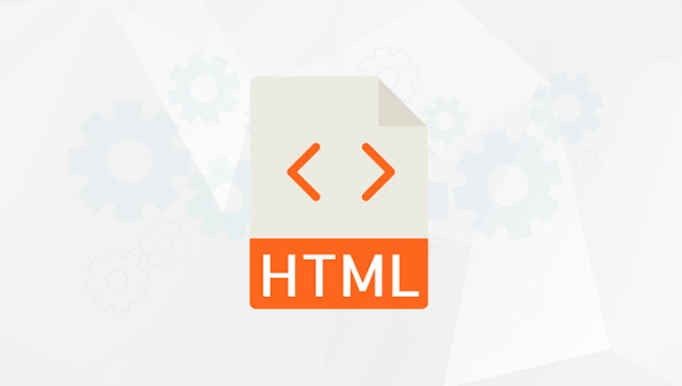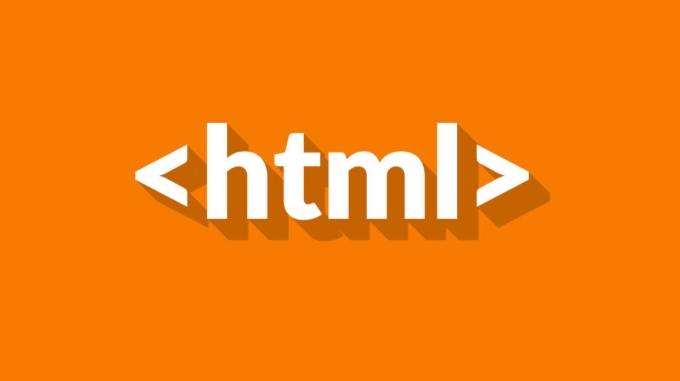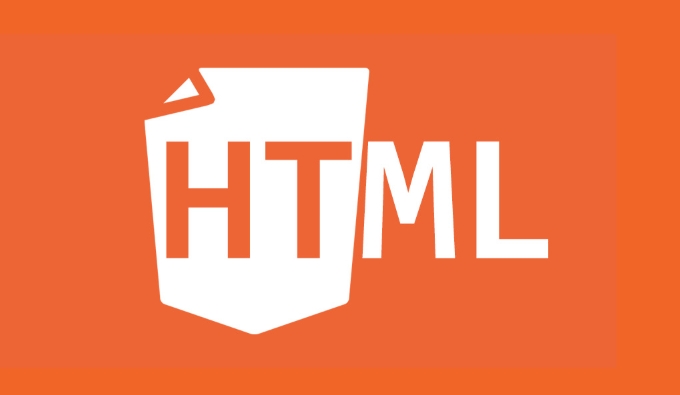The target attribute is used to specify the context of the response result display after form submission. Common values include \_blank, \_self, \_parent, \_top and custom frame names; the typical usage is to implement local updates with iframes, such as the search results are displayed in a fixed area of the page; the application scenarios have traditional system maintenance, compatible with old browsers, and no need for complex JS. Notes include that the name and target values must be consistent, the target iframe removal will affect behavior, and it is recommended to use AJAX in modern development.

Opening a new page or specifying a framework when submitting a form can actually be easily achieved through target attribute. Although this property is not often mentioned, it is very useful in some scenarios, especially when you want to display the form submission results without leaving the current page.

What is target attribute?
The <form></form> tag in HTML has a target attribute, which specifies the context in which the response result should be displayed after submitting the form. Simply put, it is to tell the browser: after submitting the data, where will the result be displayed.
Common values include:

-
_blank: Open in a new tab -
_self: Open in the current window/tab page (default) -
_parent: Open in parent framework set -
_top: Opens throughout the window, clears all frames - Or a custom frame name (for example, if you have
<iframe name="resultFrame"></iframe>on your page, you can settarget="resultFrame")
How to use target to control the display position after the form is submitted?
The most typical way to use it is to use it in conjunction with <iframe></iframe> . For example, if you want the user to submit search content, but do not want to jump to the page, but want to display the results in a fixed area, you can write it like this:
<form action="/search" method="get" target="searchResultFrame"> <input type="text" name="q" /> <button type="submit">Search</button> </form> <iframe name="searchResultFrame" style="width:100%; height:300px;"></iframe>
In this way, after the user submits the search, the results will be displayed in the iframe below, rather than the entire page refresh.

This approach is very common in some old systems or nested layouts, and is especially suitable for scenarios where local updates are required.
Common usage scenarios and precautions
Practical application scenarios:
- The results after the form is submitted are displayed in a certain area within the page (such as data preview of the ad background)
- Multiple forms share the same iframe to display results
- Keep the main page unchanged when uploading files (although most of them are now using AJAX)
Things to note:
- Don't misspel the values of
nameandtarget, otherwise it won't take effect - If the target iframe is removed or renamed, the behavior may be uncontrollable
- In modern front-end development, it is more inclined to submit forms using JS/AJAX, so this attribute is used less.
- In terms of SEO and user experience, iframe methods are not as friendly as SPA or asynchronous loading
When should I consider using it?
If you are maintaining a traditional web system or need to be compatible with old browser functions, target attribute still has its value. Especially when complex JS is not required, the "refreshless" effect can be achieved quickly.
Of course, if the project allows JavaScript, it is recommended to use fetch or XMLHttpRequest to control form submission, which will be more flexible and more compatibility.
Basically all this is it. Although it is not a high-level skill, it can save a lot of trouble in specific scenarios after understanding it.
The above is the detailed content of HTML `form` `target` Attribute for Submission Frame. For more information, please follow other related articles on the PHP Chinese website!

Hot AI Tools

Undress AI Tool
Undress images for free

Undresser.AI Undress
AI-powered app for creating realistic nude photos

AI Clothes Remover
Online AI tool for removing clothes from photos.

Clothoff.io
AI clothes remover

Video Face Swap
Swap faces in any video effortlessly with our completely free AI face swap tool!

Hot Article

Hot Tools

Notepad++7.3.1
Easy-to-use and free code editor

SublimeText3 Chinese version
Chinese version, very easy to use

Zend Studio 13.0.1
Powerful PHP integrated development environment

Dreamweaver CS6
Visual web development tools

SublimeText3 Mac version
God-level code editing software (SublimeText3)
 Applying Semantic Structure with article, section, and aside in HTML
Jul 05, 2025 am 02:03 AM
Applying Semantic Structure with article, section, and aside in HTML
Jul 05, 2025 am 02:03 AM
The rational use of semantic tags in HTML can improve page structure clarity, accessibility and SEO effects. 1. Used for independent content blocks, such as blog posts or comments, it must be self-contained; 2. Used for classification related content, usually including titles, and is suitable for different modules of the page; 3. Used for auxiliary information related to the main content but not core, such as sidebar recommendations or author profiles. In actual development, labels should be combined and other, avoid excessive nesting, keep the structure simple, and verify the rationality of the structure through developer tools.
 Implementing Clickable Buttons Using the HTML button Element
Jul 07, 2025 am 02:31 AM
Implementing Clickable Buttons Using the HTML button Element
Jul 07, 2025 am 02:31 AM
To use HTML button elements to achieve clickable buttons, you must first master its basic usage and common precautions. 1. Create buttons with tags and define behaviors through type attributes (such as button, submit, reset), which is submitted by default; 2. Add interactive functions through JavaScript, which can be written inline or bind event listeners through ID to improve maintenance; 3. Use CSS to customize styles, including background color, border, rounded corners and hover/active status effects to enhance user experience; 4. Pay attention to common problems: make sure that the disabled attribute is not enabled, JS events are correctly bound, layout occlusion, and use the help of developer tools to troubleshoot exceptions. Master this
 Configuring Document Metadata Within the HTML head Element
Jul 09, 2025 am 02:30 AM
Configuring Document Metadata Within the HTML head Element
Jul 09, 2025 am 02:30 AM
Metadata in HTMLhead is crucial for SEO, social sharing, and browser behavior. 1. Set the page title and description, use and keep it concise and unique; 2. Add OpenGraph and Twitter card information to optimize social sharing effects, pay attention to the image size and use debugging tools to test; 3. Define the character set and viewport settings to ensure multi-language support is adapted to the mobile terminal; 4. Optional tags such as author copyright, robots control and canonical prevent duplicate content should also be configured reasonably.
 Best HTML tutorial for beginners in 2025
Jul 08, 2025 am 12:25 AM
Best HTML tutorial for beginners in 2025
Jul 08, 2025 am 12:25 AM
TolearnHTMLin2025,chooseatutorialthatbalanceshands-onpracticewithmodernstandardsandintegratesCSSandJavaScriptbasics.1.Prioritizehands-onlearningwithstep-by-stepprojectslikebuildingapersonalprofileorbloglayout.2.EnsureitcoversmodernHTMLelementssuchas,
 HTML for email templates tutorial
Jul 10, 2025 pm 02:01 PM
HTML for email templates tutorial
Jul 10, 2025 pm 02:01 PM
How to make HTML mail templates with good compatibility? First, you need to build a structure with tables to avoid using div flex or grid layout; secondly, all styles must be inlined and cannot rely on external CSS; then the picture should be added with alt description and use a public URL, and the buttons should be simulated with a table or td with background color; finally, you must test and adjust the details on multiple clients.
 How to associate captions with images or media using the html figure and figcaption elements?
Jul 07, 2025 am 02:30 AM
How to associate captions with images or media using the html figure and figcaption elements?
Jul 07, 2025 am 02:30 AM
Using HTML sums allows for intuitive and semantic clarity to add caption text to images or media. 1. Used to wrap independent media content, such as pictures, videos or code blocks; 2. It is placed as its explanatory text, and can be located above or below the media; 3. They not only improve the clarity of the page structure, but also enhance accessibility and SEO effect; 4. When using it, you should pay attention to avoid abuse, and apply to content that needs to be emphasized and accompanied by description, rather than ordinary decorative pictures; 5. The alt attribute that cannot be ignored, which is different from figcaption; 6. The figcaption is flexible and can be placed at the top or bottom of the figure as needed. Using these two tags correctly helps to build semantic and easy to understand web content.
 What are the most commonly used global attributes in html?
Jul 10, 2025 am 10:58 AM
What are the most commonly used global attributes in html?
Jul 10, 2025 am 10:58 AM
class, id, style, data-, and title are the most commonly used global attributes in HTML. class is used to specify one or more class names to facilitate style setting and JavaScript operations; id provides unique identifiers for elements, suitable for anchor jumps and JavaScript control; style allows for inline styles to be added, suitable for temporary debugging but not recommended for large-scale use; data-properties are used to store custom data, which is convenient for front-end and back-end interaction; title is used to add mouseover prompts, but its style and behavior are limited by the browser. Reasonable selection of these attributes can improve development efficiency and user experience.
 How to handle forms submission in HTML without a server?
Jul 09, 2025 am 01:14 AM
How to handle forms submission in HTML without a server?
Jul 09, 2025 am 01:14 AM
When there is no backend server, HTML form submission can still be processed through front-end technology or third-party services. Specific methods include: 1. Use JavaScript to intercept form submissions to achieve input verification and user feedback, but the data will not be persisted; 2. Use third-party serverless form services such as Formspree to collect data and provide email notification and redirection functions; 3. Use localStorage to store temporary client data, which is suitable for saving user preferences or managing single-page application status, but is not suitable for long-term storage of sensitive information.






